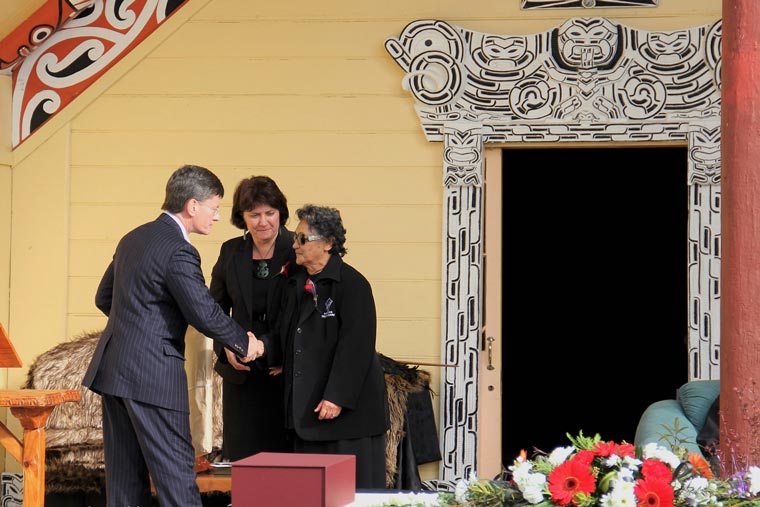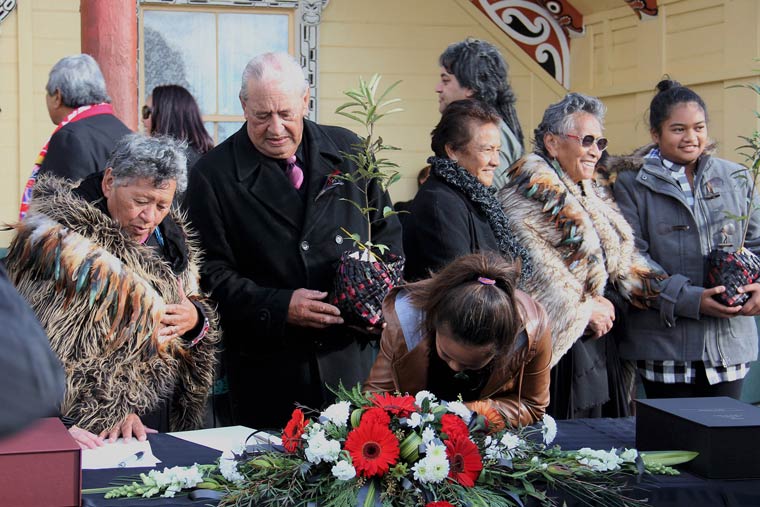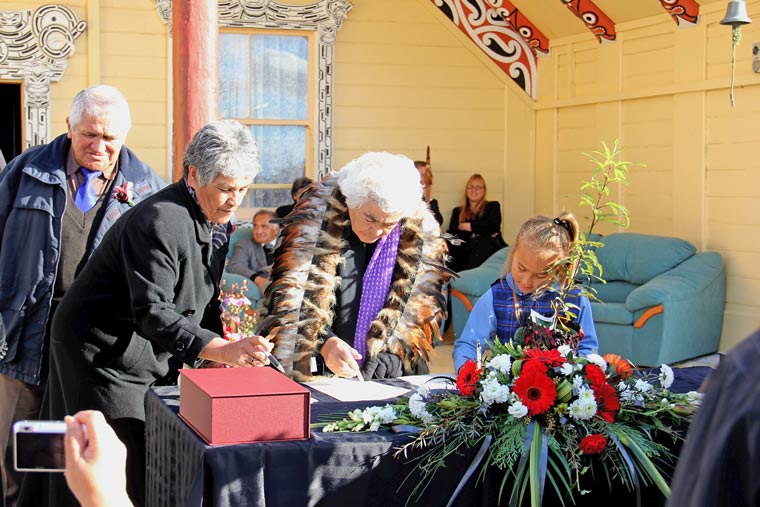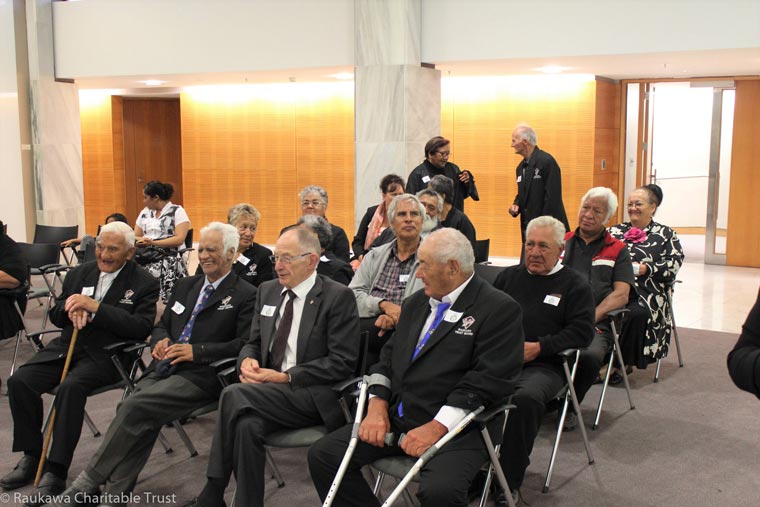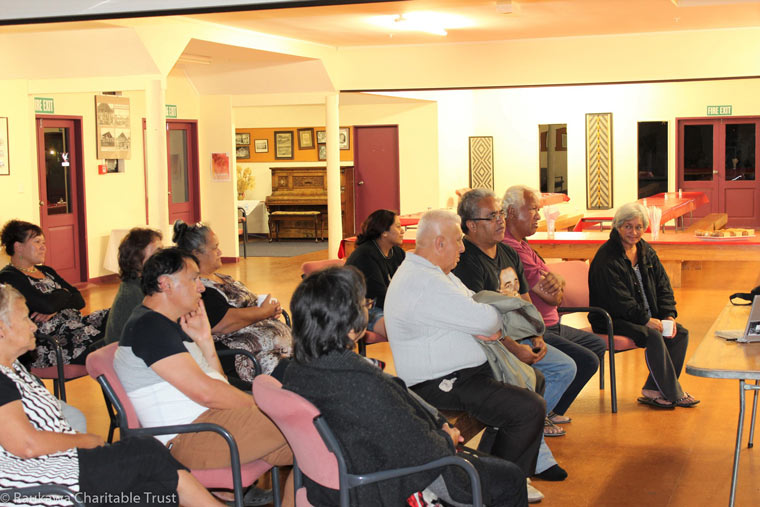On 2 June 2012, the iwi of Raukawa assembled at Aotearoa marae to participate in the signing of the Deed of Settlement of the Raukawa historical treaty claims.
For many, the signing of the Deed was the culmination of the aspirations of Raukawa kaumātua that lodged the original iwi claims in the Waitangi Tribunal in 1989. These claims led to two decades of working towards finalising an enduring settlement that recognised the loss, heartache and pain suffered by the whānau, hapū and iwi of Raukawa because of Crown breaches of the Treaty.
To others, the day meant being a part of an event that shaped the future of the iwi.
After the formalities, the iwi was then invited to sign the Deed of Settlement. When all the marae had signed the Deed, Minister Chris Finlayson and Vanessa Eparaima then signed.
The signing of the Raukawa Deed of Settlement closed a chapter in the long history of the iwi of Raukawa and opened a new one. The day heralded a new way forward for the iwi as the iwi began to heal from the wrongs of the past.
Deed of Settlement interviewees
Video transcript
Cheryl Pakuru:
‘(In regard to being present at the DoS signing) Yes, at Aotearoa marae.
(In regard to your most vivid memory of the day) Nigel forgetting our marae. That was probably the thing that I will never forget. But the biggest memory I have on that day, whilst the celebrations were happening and having Ngāti Korokī Kahukura there. Seeing everybody who had been part of the process, having Mōtai-Tangata-Rau with us, it was amazing. But the biggest thing that I will remember from that was not having George Rangitutia there with us. He was...Oh see here is a name I didn’t actually bring up when I was talking about the leaders of the time...that will be the one thing that I will always remember. He wasn’t with us the day that we reached settlement.’
Chris McKenzie:
‘By the time we got to the Deed of Settlement stage, which is the second to last stage before legislation, we had pretty much exhausted our resources. We had next to no money for legal fees. So I remember we had this 2000 page legal document, that we were spending weeks going clause by clause, trying to find any errors or omissions or areas where the tribe is going to be disadvantaged in the future. It was really, really tough going. Actually, not having a legal background myself, this culminated then in a Deed of Settlement.
As our negotiator, once again I couldn’t wait for the day, not because I was excited by it, but because it meant the end. I had made a promise to myself that I would resign the day that the Deed was signed. That my work would be over. I didn’t want to be involved in the development. I had committed my life for nearly ten years. Day in day out to this work and I couldn’t wait to go to my kids rugby game or you know, go to one parent interview with my daughter. I was really looking forward to it. The time was dragging and so it was a bitter sweet day for me, I didn’t enjoy it at all, until I could feel the excitement of people around me. I had sort of forgotten why we were doing this. This was a big day for people. People were excited by it. There were big numbers of people turning up.
I had selfishly just thought about myself, thinking “I can’t wait to get it over and done with.” You know, people turned up early and one of the cousin’s from Wharepūhunga started getting the haka pōwhiri ready. People looked good. We wore our colours. There was a huge crowd there. The food was being cooked. Lots of visitors came from everywhere and I thought “Wow, look at that! That’s amazing!”
I had been away, you know, prior to the Deed signing day for a little while anyway. I looked across the line of people and the pae. What’s something that stood out for me was the long line that we had on our pae. I had never seen it that long before and it wasn’t only our kaumātua, you know, we had some Mayors in there. We had, you know, important people.
It was five rows thick and long. I couldn’t believe how big it was. Then the next five rows was just kuia. In fact, you know, people of my generation were lucky if they got a seat on the ground. Everyone looked proud and happy. I remember that the most, I don’t go in for much of the formalities, I signed it because I wanted to get my name written on it into history, but...
The settlement day was just like many other days, an important day which marked the end of one thing and the beginning of something else. Since settlement day, there has been many days like that which probably didn’t get as much attention but are equally important.’
Miriata Te Hiko:
‘(Were you present on the day of the signing) Yeah the overall day was awesome. We had Finlayson who did the Crown apology. Raukawa also provided each of the marae... it was the presentation of this taonga that Korokī Kahukura gave at the settlement. (In regard to the gift). To me that felt like, even though they had withdrawn from our Treaty claims, from our board, they were still very much Raukawa. This symbolised that. To me this is what this symbolised. That they are Raukawa.
To me I thought how beautiful is that and to be presented with something like this from Korokī Kahukura.
(In regard to the DoS what was the revolutionary achievement). That we finally got Deed of Settlement for Raukawa and the apology. All the marae could celebrate because we all got korowai.
The whole day was just overwhelming and the taonga being presented from Korokī Kahukura. The only... the saddest thing about it was the Chair, George Ranguitutia was in hospital, so he wasn’t there to share in the celebrations of that day. Chris Finlayson went to the hospital and visited (him) personally. So that was awesome. The whole day. I want to say that this little trinkle of what I saw was just light tear drops falling down over the marae and over the people...he heke te roimata. Āe, he ua i te ata. During everything it occurred.
So, you know the overall feeling as a whole, all our kaumātua and kuia are all with us today in this big celebration.’
Nigel Te Hiko:
‘I should also mention that it was at the pōwhiri that we had for the iwi, that our whanaunga from Ngāti Korokī Kahukura also came on as well and with them they bought the greenstone patu, a greenstone mere. It was Karaitiana who took that mere and laid it on the ātea. It was a reconcilliation between us.
Our Paraone Gloyne went out and picked it up, but he carried with him also in recognition, one of the Raukawa trees that we had presented to our marae. He then presented the Ngāti Korokī Kahukura with the Raukawa tree.
So here we have the mere or the patu that had been named “Raukawa” by Ngāti Korokī Kahukura that had been given to us and we recipricated by giving them a live Rakawa tree to help cement and to help heal some of the mamae that had existed between us. It was a very touching part of the ceremony that I remember considering the issues that we had.
Following the pōwhiri for the iwi, the Minister arrived. Tumu arrived as well, so the Ariki for Tūwharetoa had arrived and so we had the pōwhiri for the Minister and for Tumu. So they came on and they joined Dame Tariana up on the ātāmira.’
Ruthana Begbie:
‘Apart from all the hardcase things that happened, and all the not...All the hardcase things, especially when our MC forgets one of the hapū. Kūware that was (giggles)... But he’s allowed! One good thing for the rest of us is that we know that he’s not allowed to forget it either. If it was Ngāti Huri that he had forgotten, he wouldn’t be alive today. So that’s a hardcase one. We can laugh about it because, it’s us!
The biggest thing I guess for me was the fact that the Minister of Treaty Settlements, Chris Finlayson gave the Crown Apology. He was very genuine about how he gave it. I think I couldn’t help but be moved at the way that he delivered that.
It will always be something significant for me that I remember, it was the crowning glory really in terms of Raukawa’s relationship with the Minister because he came across as being a very personal apology as well. It was heartwarming to know that at least there was one politician that was affected by the injustices of our people by the Crown. So I think that was hugely significant.
Of course baring in mind the tohu that was laid at Raukawa’s feet. Our taonga here that Korokī Kahukura placed on Aotearoa. That in itself was significant because it was a difficult time in terms of relationship between Raukawa and Korokī Kahukura. It should never have come to that.
Unfortunately, like I said at the beginning that leadership in this whole process was a key element as to how successful we were going to be and we struggled at times with the leadership. We struggled when we were confronted by other iwi leadership, who were none to kind to us.
The taonga was certainly something I will always remember the signing for when I look back on the settlement, its the tohu that was placed for Raukawa and how it’s helped to heal the rift that the process has created. I think it was a good crowning glory for the signing of the Deed.
(In regard to the achievement of the settlement). The most significant achievement? I think the most significant achievement for Raukawa is realising that here are 16 hapū that have worked through this whole settlement process, with one aim in mind and that’s to be able to achieve to come out better than how we started.
To be able to say to our mokopuna that what they’ve got today and what they’ll have tomorrow is as a result of the setlement that we achieved today.
So I think that’s a huge achievement for us. Providing a foundation for our mokopunas (sic) to continue to hold their head high, to aim for the stars and to never forget who they are and where they come from.’
Vanessa Eparaima:
‘So, a really incredible journey and some very challenging times along the way, to help to set the pathway, to journey along this pathway, in the face of adversity, in the face of love, in the face of challenges of working out who we were collectively and how we were going to do this thing.
So I believe in 2012, I took over the negotiation role with my cousin Nigel Te Hiko and we completed our Deed of Settlement signing was in June 2012, June, 2. It was an incredible journey to which to say, I still can’t believe that I was a part of.’
Phyllis Tahere:
‘(Were you present on the day of the signing?) Yeah, I was present, I was present at Aotearoa. That was once again a magical day. There was one particular highlight I want to mention and I think that carved the morning on the day.
The day of the signing, when you woke up yes it was a bit foggy, a bit misty but it rose and then we had a beautiful day.
Then it came time for the pōwhiri between the iwi that had been invited and then the Crown and then the apology.
Then the iwi acknowledged the Treaty team as a whole and so as part of their acknowledgement to the Treaty team for finishing, well getting us through to the signing.
They gave each and every one a taonga. The Treaty team were called out one by one and acknowledged in front of all the iwi, as well as our visiting iwi and in front of the Crown of their work… towards the settlement.
So, one by one we got called out, not only ourselves as a team but our lawyers as well Baden Vertongen and Anne Haira, they were acknowledged as well for their work that they did on behalf of the iwi of Raukawa.
One of our other consultants as well Jon Stokes was another one who especially on our communications around the logistics of the day and the… lead up to it, I’d like to mention him to, he was one of those that helped us for that day.
So that was something memorable for myself, to be in front of the iwi receiving this taonga on behalf of them, from the iwi.
The second one that I would like to mention. When it came time for the actual signing, out at Wharepūhunga, the sun was actually starting to go down a bit, it was getting a bit cold, it was starting to lose its day. Then all you hear was this “Woof, woof, woof, woof” and these pigeons, these Kererū come flying around inside. You know, we were all out on the ātea but they just flew back and forward, back and forward and this was at the time when the signing was taking place. You never saw them earlier, but right on the time of the signing, that’s when these pigeons, these Kererū.
You know, one thing I am really aware of, “He tohu, he tohu tērā” it was beautiful. It was really beautiful.
That’s something that I will never forget on the day of our deed of settlement. Yip, everything else was just as beautiful too or just as momentous as well, but that’s a moment that sticks in my mind, when those Kererū, it was beautiful…it was just a tohu for us that was sitting there.
The crack up thing about it was, some of the kōroua... sitting behind some of the kōroua they were like “anybody got a gun?” You know, or “oh somebody got a shangai?” cos they were huge, these Kererū were huge. Some of the kōrero from our kōroua and kuia from out at Wharepūhunga, “yes they do have Kererū quite a bit out there, but they hadn’t seen them for a very long time”.
To have them fly in at that moment, at that time, on that occasion sealed it as far as I was concerned.’
Interviewees: Cheryl Pakuru, Chris McKenzie, Miriata Te Hiko, Nigel Te Hiko, Ruthana Begbie, Vanessa Eparaima and Phyllis Tahere.
The whaikōrero that followed emphasised the importance of the day to the iwi. A poignant moment during the pōwhiri was the laying of a greenstone mere, named ‘Raukawa’ by Ngāti Korokī Kahukura, Karaitiana Tamatea, upon the marae ātea.
As Paraone Gloyne strode across the marae to retrieve the gift, he carried with him the humble Raukawa tree, which he presented to Ngāti Korokī Kahukura in reciprocation. This was a humbling exchange, one deeply felt by all present.
Following the pōwhiri, all the iwi mingled keenly awaiting the arrival of the Crown. Shortly after 11:30am, the Crown arrived at the gate.
Minister of Treaty Negotiations, Chris Finlayson stood with his parliamentary colleagues Louise Upston and Denise Roach and his staff waiting for the karanga. Next to him stood the Ariki Sir Tumu te Heuheu of Tūwharetoa. Advancing on the visitors were the kaiwero led by Paraone Gloyne, expertly utilising the newly gifted mere, ‘Raukawa’.
The marae erupted as the fierce chant of the ‘Haka a Wairangi’ pierced the still air. The visitors moved forward with the Ariki and the Minister taking their seats upon the mahau of Hoturoa. The welcoming speeches highlighted again the importance of the day to the people of Raukawa and the significance of the relationship between Raukawa and the Crown.
Following the pōwhiri, the official signing ceremony began with karakia led by Rev. Ngira Simmonds with an opening address by Basil Pakaru, ‘koroua of Raukawa’. The address was originally to be given by George Rangitutia, but due to illness was not able to be at the celebrations. As a mark of respect, Minister Finlayson immediately went to visit George Rangitutia in hospital after the signing.
In his opening statements, Pakaru acknowledged the contribution of Rangitutia to the ‘…realisation of our iwi dream’. He went on to also acknowledge the contributory work of all those that had worked upon the Treaty claims, including kaumātua, claimants, previous treaty claims managers, lawyers and past and present Treaty teams.
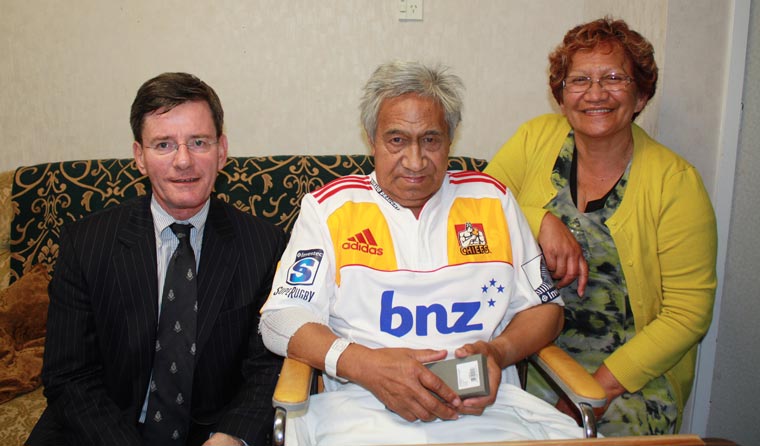
Following Pakaru’s address the Minister, Chris Finlayson stood before the people. The Minister reflected upon the special relationship that he had developed and fostered with Raukawa over the years. He said that the relationship began when he was a speaker for the opposition.
He recounted having dealt with the Raukawa team and said 'Raukawa had taken a very innovative and pragmatic approach to its Treaty settlements' . Humbly, the Minister went on to deliver the Crown’s apology to Raukawa for having caused Raukawa hurt and pain because of the Crown’s breaches.
Vanessa Eparaima, Chair of the Raukawa Settlement Trust, delivered the final address. Eparaima acknowledged the relationship between Raukawa and the Crown and highlighted the importance of maintaining strong relationships. It was with solemnity that Vanessa was able to draw upon the example of Nanny Kahurangi Te Hiko in accepting the Crown’s apology on behalf of the iwi.
